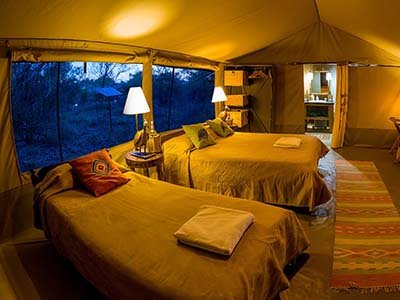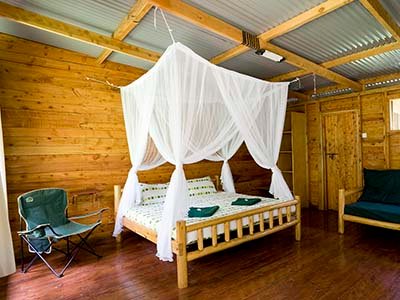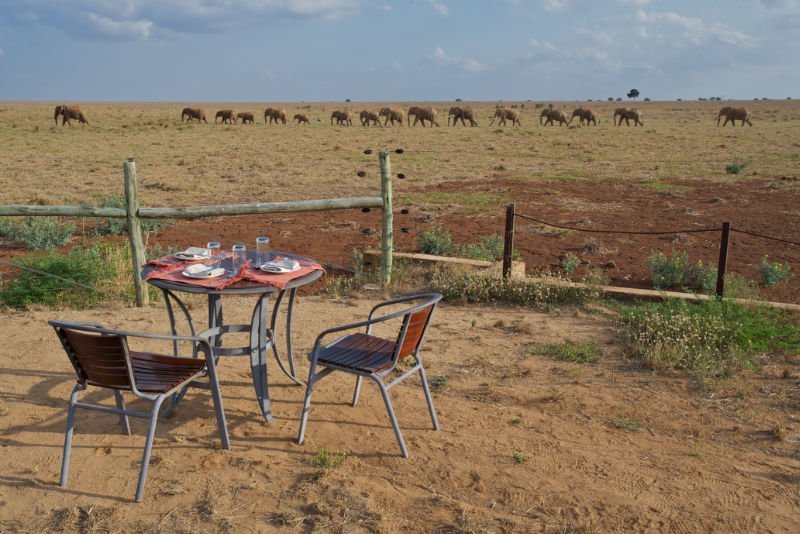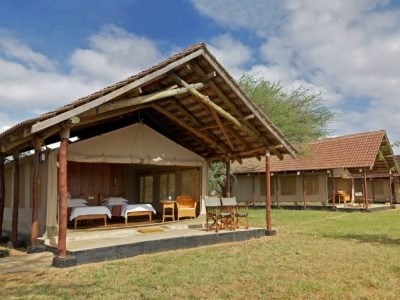Tsavo East National Park
Tsavo East National Park, Kenya
Tsavo East National Park was opened in April 1948 which makes it one of the oldest and largest parks in Kenya, it forms the largest protected area in Kenya at 13,747 square kilometres. Situated in a semi-arid area previously known as the Taru Desert, and is located near the town of Voi in the Taita-Taveta County of the former Coast Province. However, it is managed by Kenya Wildlife Service (KWS)
It is within one of the largest protected areas in the world the Tsavo Conservation Area
The Tsavo Conservation Area (also known as the Tsavo Ecosystem) is a network of protected and non-protected wildlife habitats in southern Kenya and north-eastern Tanzania. It consists of Tsavo East National Park, Tsavo West National Park, Chyulu Hills National Park, South Kitui National Reserve, ranches in Galana, Taita, Kulalu, and Amboseli, as well as surrounding private and community areas. The Tsavo Conservation Area, which borders Tanzania’s Mkomazi National Park, covers around 42,000 km2, of which over 25,000 km2 is protected. Kenya’s protected areas account for over half of the country’s total territory.
The park which is almost 10 times bigger than Maasai Mara is divided into east and west sections by the A109 road and a railway. Named for the Tsavo River, which flows west to east through the national park, it borders the Chyulu Hills National Park and the Mkomazi Game Reserve in Tanzania.
Inside Tsavo East National Park, the Athi and Tsavo rivers converge to form the Galana River. Most of the park consists of semi-arid grasslands and savanna. It is considered one of the world’s biodiversity strongholds, and its popularity is mostly due to the vast amounts of diverse wildlife that can be seen.
Tsavo East National Park is generally flat, with dry open plains across which the Galana River flows. Other features include the Yatta Plateau and Lugard Falls.
Tsavo West National Park is more mountainous and wetter, with swamps, Lake Jipe and the Mzima Springs.
Wildlife and Game viewing in Tsavo East National Park, Kenya

The lion, black rhino, cape buffalo, leopard, and elephant are among the well-known “big five” animals that may be seen in Kenya’s Tsavo East National Park, which is also home to a wide variety of other animals. The park is especially well-known for its exceptional “red elephants,” who are distinguished by their unusual dust baths. The park is one of the biggest game reserves in the world, and it is home to a huge variety of animals due to its vast, untamed wilderness regions.
The Tsavo lions, whose mature males frequently have completely hairless manes, are one of the park’s most well-known groups. In the Amboseli-Tsavo habitat, there are around 675 lions in total. They are not the only predators present in the park, though. Black-backed and side-striped jackals, as well as spotted and striped hyenas, may all be seen roaming the savannah. While they are secretive and challenging to identify, leopards may also be spotted in the park.
In addition to the large predators, a wide range of other mammals call Tsavo East National Park home. Large herbivores like giraffes, elephants, zebras, and waterbucks are present. In addition, there are many smaller mammals such as the bush squirrel, African red squirrel, and striped ground squirrel.
The park is also home to numerous species of antelopes, such as the Kilpsringer, Grant’s gazelle, and Gerenuk, Impala, Coke’s hartebeest, Hunter’s hartebeest, Blue, Bush, and Harvey’s red duikers, Common eland, Ellipsen waterbuck. These animals often form the bulk of the predators’ diet, and visitors to the park can observe them grazing in the park’s vast grasslands.
One of the unique species found in Tsavo East National Park is the Grevy’s zebra the largest living wild equid. This species is endangered, with only about 3,000 individuals remaining in the wild. However, visitors to the park have a chance to see them in their natural habitat. The Plains zebra also inhabits the savanna
The park is also home to a variety of small carnivores such as the African wildcat, caracal, and serval. These animals are not as well-known as the big cats, but they are still a fascinating sight to see.
Tsavo East National Park is also home to many primates, including the yellow baboon, Vervet monkey, and Sykes’ monkey. These intelligent animals are often seen in groups and can provide entertaining moments for visitors.
Birds and Bird Watching
For birders and bird watchers, Tsavo East National Park is a haven. 455 different bird species, both migratory and permanent, are included on the park’s bird checklist. This park is a great place for water birds to nest because of its close proximity to the ocean. The park is covered with a variety of plants, ranging from wetlands to rocky terrain.
The park’s distinctive topography includes several rocky outcrops that provide excellent bird homes. The Yatta Plateau, the world’s longest flat lava ridge, is also a great place for birds to live.
The Athi River and Tsavo River, which border the park, are home to a number of aquatic bird species, including the Papyrus Gonolek. The park is a great place to go bird watching because of its tranquil atmosphere and minimal visitor traffic.
The African darter, Saddle-billed Stork, Martial Eagle, and white-headed Vulture are some of the unique birds that frequent the area.
The park’s diversified natural habitat has drawn a broad range of permanent resident bird species, including the Somalia bee-eater, Common and Masai ostriches, Taita falcon, African finfoot, The Vulturine Guineafowl, Slender-tailed Nightjar, Shelley’s Starling, Rufous Chatterer, Red-bellied Parrot, Northern Brownbul, Pangani Longclaw, and Golden-breasted StarlingThe park is a popular stopping spot for migrating birds since it is situated along their route as they go from the Middle East to other European nations. The park’s environment makes it a great place to go bird watching any time of year, although the green season is when activity is at its most. The rainy season is when the birds breed and are plainly seen.
The park’s vegetation ranges from marshy to stony, with the dry open savannah vegetation predominating. The diverse distribution of bird species in the park is largely due to its topography. This area is far from the crowded beach region and situated in a secluded Taru semi-desert. On the edge of the well-known interior plateau, it is situated in an open, low-lying, and semi-arid region of the nation. A decent roadway and train that runs from the capital city to the major Mombasa commercial district traverse the park in its middle, making it accessible.
The majority of the park’s northern region is made up of grasslands, which are controlled by sizable herds of elephants and other grazers. Baobab trees may be found all along the longest lava flow in the world, the Yatta Plateau, which extends from the park’s western edge and goes beneath the Athi River. Throughout the plateau, there are also temporary water catchment sites where birds congregate to bathe, particularly during the dry season. Tsavo East National Park is drier than Tsavo West National Park, which receives up to 450 mm more annual rainfall. Due to the park’s dry vegetation, birders may now visit at any time of the year to enjoy bird watching.
Because of the peace and quiet of the park, the birds may be seen playing in the open areas. To readily identify the birds of Tsavo East National Park, you must have a knowledgeable and experienced birding guide.
Activities and Attractions
Tsavo East National Park is a popular destination for visitors seeking to experience the natural beauty and diverse wildlife of Kenya. Here are some of the top activities and attractions that visitors can enjoy in Tsavo East National Park:
- Game drives: For a memorable safari experience, visitors can embark on a guided game drive in Tsavo East National Park to see a variety of wildlife such as large herds of elephants, lions, leopards, cheetahs, buffalo, giraffes, zebras, lesser kudu, and many more.
- Bird watching: Tsavo East National Park is home to over 500 bird species, making it a great destination for birdwatchers. Visitors can spot birds such as the secretary bird, martial eagle, ostrich, and African fish eagle.
- Walking safaris: For a more intimate experience with nature explore the park on foot, visitors can go on walking safaris with an armed ranger, where they can see wildlife up close and learn about the plants and animals of the park. The favourite is a guided walk along the Galana river whose banks are dotted with doum palms.
- Cultural visits: Visitors can visit nearby villages to learn about the local culture and way of life of the communities that live around Tsavo East National Park.
- Rock climbing: Visitors can climb the Lugard Falls, a series of rapids and waterfalls on the Galana River, for a thrilling adventure.
- Hiking and trekking: Visitors can go on guided hikes and treks in Tsavo East National Park to explore the rugged terrain, scenic landscapes, and wildlife habitats.
- Scenic drives: Tsavo East National Park offers stunning landscapes and scenic drives, including the Aruba Dam, Mudanda rock and the Yatta Plateau, the world’s longest lava flow.
LOCAL COMMUNITIES
Two large community-based conservation programs that border the official Protected Areas of Tsavo East and Tsavo West National Parks have been formed during the past seven years.
Shirango Community Conservancy (with the Watha and Giriama people) and Kamungi Conservancy (with the WaKamba people) share the southern boundary of Tsavo East.
While these marginalized populations have benefited in many different ways from the conservancy concept, both conservancies have formed an essential conservation buffer for the PAs.
WEATHER AND CLIMATE
Dry season
From June through September
The coldest months are during the dry season.
June and July are often bright months. Around 84°F/29°C is the typical afternoon temperature.
August and September – The average temperature in September is 30°C/86°F, although it may reach considerably hotter. Temperatures rise during the day before the rain.
Wet season
From October through May
The short rains’ and ‘long rains’ are separated by a dry spell in January and February. In April and May, road conditions are at their worst.
Throughout the months of October, November, and December, The start of the rainy season is often around October. One of the wettest months of the year is November. Rain does not usually continue all day, although afternoon thunderstorms are possible. The average temperature during the day is 32°C/90°F.
January and February provide a respite from the brief and lengthy rains. The length of this dry spell is impossible to estimate. February is consistently the warmest month, with an average afternoon temperature of 33°C/91°F and higher maxima.
March, April, and May – Long rains often commence in late March. It seldom rains all day, although afternoon showers are possible. The month of April gets the most rain. The afternoon temperature is around 32°C/90°F.
GETTING TO THE PARK
You may travel by car a distance of around 233 kilometres to reach Tsavo East National Park from Mombasa. Depending on the amount of traffic, the trip might take anywhere from three to four hours. It is possible to take a cab, either individually or with others, or to rent a car and drive yourself. You may also take a shuttle bus from Mombasa to the nearby town of Voi and then take a cab to the park’s entrance.
Many different local airlines offer service between Moi International Airport in Mombasa and Voi Airstrip in Tsavo East National Park. The flight time ranges from 30 minutes to 45 minutes, depending on the carrier and the kind of plane. It is possible to catch a cab or be picked up by your accommodation provider at the Voi Airstrip after landing in the park. For those looking to bypass the lengthy drive from Mombasa to Tsavo East National Park, flying is a quick and easy alternative.
You may take a plane or a bus from Nairobi. The trip takes roughly four to five hours on the road, and it’s about 233 kilometers. You can take a shuttle bus, a taxi, or a hired automobile. Domestic flights from Nairobi will land you at Voi Airstrip, which is close to the park; from there, you may take a cab or have your hotel arrange for a pick-up. It takes roughly 45 minutes to fly there.
ACCOMMODATION OPTIONS
Tsavo East National Park offers a range of accommodation options to suit different budgets and preferences. Visitors can choose from a variety of lodges, tented camps, and campsites located both inside and outside the park. Here are some examples of lodges and campsites in Tsavo East National Park:
- Ashnil Aruba Lodge: A luxurious lodge located near the Aruba Dam, with spacious rooms and an outdoor pool.
- Voi Wildlife Lodge: A mid-range lodge with views of the Tsavo East plains, featuring an outdoor pool and a waterhole for game viewing.
- Galdessa Camp: An eco-friendly tented camp located on the banks of the Galana River, with comfortable tents and a swimming pool.
- Ndololo Camp: A budget-friendly campsite located in the heart of Tsavo East National Park, offering basic tents and camping facilities.
- Manyatta Camp: A semi-permanent tented camp located near the Voi River, with comfortable tents and an outdoor dining area.
- Satao Camp: A luxurious tented camp located in a private conservancy adjacent to Tsavo East National Park, featuring spacious tents and an outdoor pool.
- Sentrim Tsavo Camp: A mid-range tented camp located near the Voi Gate, offering comfortable tents and an outdoor pool.
___________________________
SAMPLE 1-DAY TRIP FOR A FIRST-TIME VISITOR TO TSAVO EAST NATIONAL PARK:
We will pick you up at your Diani or Mombasa Island hotel or home as the sun rises over the beautiful Kenyan coast. Where are we going? The infamous Man-Eating Lions previously roamed Tsavo East National Park.
We will enter the park gates after a lovely journey through the magnificent countryside. The excitement of expectation rises as we step inside. As there isn’t a lot of foliage in Kenya’s largest park, Tsavo East National Park, you can see all the animals well. The rare Tsavo lions, whose males lack the typical large manes, will be out and about for you to observe. Keep a look out for elephants as well; they like to show off their vivid coats by rolling in the red-dust soil as they make their way to one of the park’s many drinking holes.
During your 6-7 hour game drive, our knowledgeable guide will lead you across the wide landscape of the park, hoping to spot some of the park’s many interesting animals. Feel the rush of exploration as you drive through the park’s many landscapes and uncover its hidden gems with the windows down and the wind in your hair. We’re going to take a break and have lunch in the middle of the park. Nothing beats sitting down to lunch in the middle of the African bush, surrounded by wildlife and the sounds of the wild.
We will leave the park as the day winds down and return to the place you were dropped off. We should be there between 6:30 and 7:30 PM, but it totally depends on traffic. Yet, the experience of exploring Tsavo East National Park will remain in your heart forever. Hence, there’s no need to hold off. Come with us on a fantastic day’s journey into the wild heart of Kenya.
_________________________
FAQs






